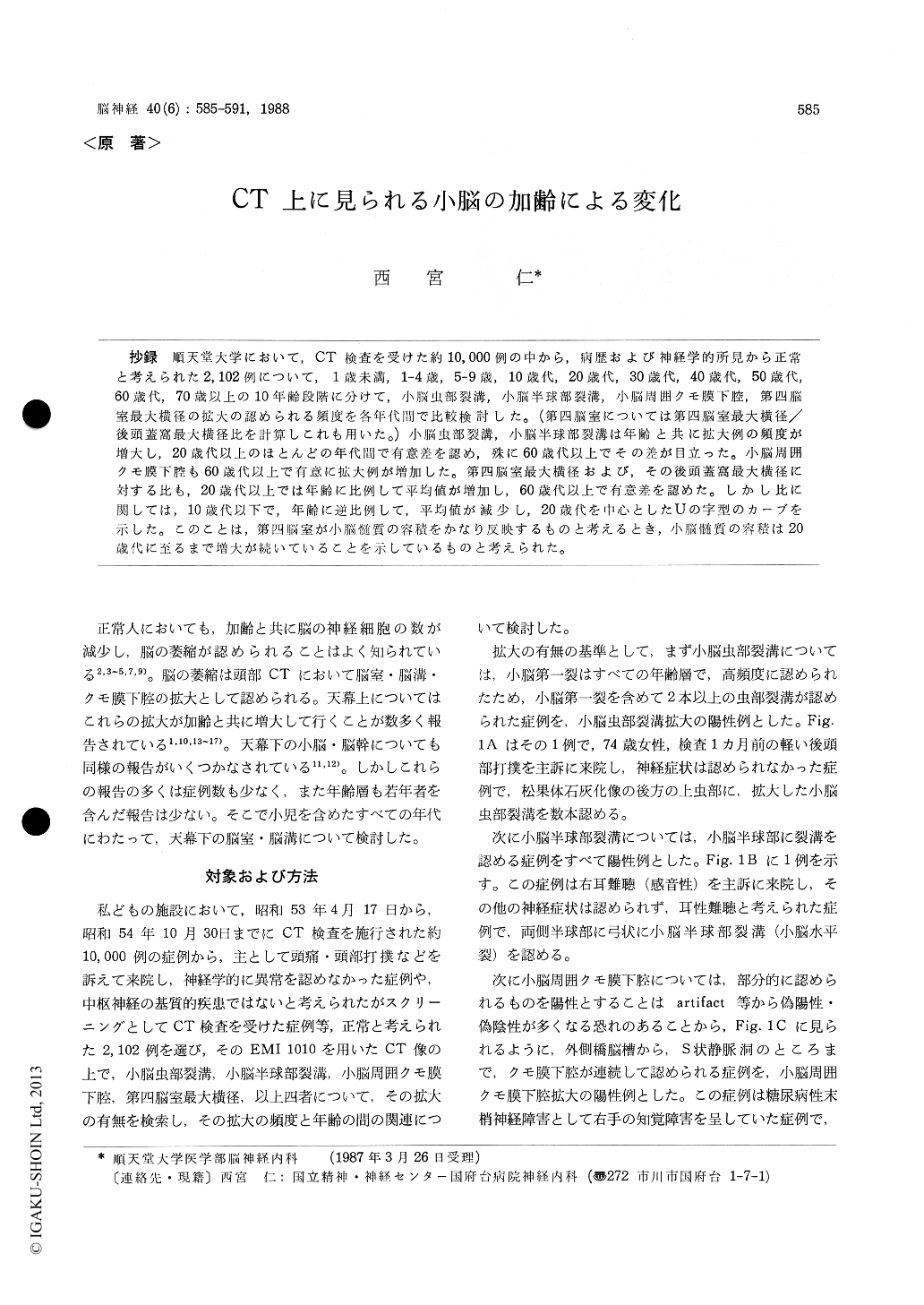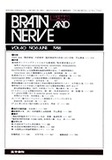Japanese
English
- 有料閲覧
- Abstract 文献概要
- 1ページ目 Look Inside
抄録 順天堂大学において,CT検査を受けた約10,000例の中から,病歴および神経学的所見から正常と考えられた2,102例について,1歳未満,1-4歳,5-9歳,10歳代,20歳代,30歳代,40歳代,50歳代,60歳代,70歳以上の10年齢段階に分けて,小脳虫部裂溝,小脳半球部裂溝,小脳周囲クモ膜下腔,第四脳室最大横径の拡大の認められる頻度を各年代間で比較検討した。(第四脳室については第四脳室最大横径/後頭蓋窩最大横径比を計算しこれも用いた。)小脳虫部裂溝,小脳半球部裂溝は年齢と共に拡大例の頻度が増大し,20歳代以上のほとんどの年代間で有意差を認め,殊に60歳代以上でその差が目立った。小脳周囲クモ膜下腔も60歳代以上で有意に拡大例が増加した。第四脳室最大横径および,その後頭蓋窩最大横径に対する比も,20歳代以上では年齢に比例して平均値が増加し,60歳代以上で有意差を認めた。しかし比に関しては,10歳代以下で,年齢に逆比例して,平均値が減少し,20歳代を中心としたUの字型のカーブを示した。このことは,第四脳室が小脳髄質の容積をかなり反映するものと考えるとき,小脳髄質の容積は20歳代に至るまで増大が続いていることを示しているものと考えられた。
The author studied the incidence of computed tomographic evidences of cerebellar atrophy in 2,102 neurologically normal subjects. The sub-jects were selected from approximately 10,000 cases who underwent CT examination at Juntendo University hospital since April 17, 1978 to October 30, 1979. The 2,102 subjects were clas-sified into 10 groups according to their age, as fol-lowing : 1) below the age of 1 year, 2) between 1 and 4 years, 3) between 5 and 9 years, 4) second decade, 5) third decade, 6) fourth decade, 7) fifth decade, 8) sixth decade, 9) seventh decade, 10) after the age of seventy. The incidence of en-larged cerebellar vermis fissures, cerebellar hemi-spheric fissures, subarachnoid space around the cerebellum and the fourth ventricle were explored on CT. As regards the fourth ventricle, the maxi-mum transverse width of the fourth ventricle and the maximum inside diameter of the posterior fossa were measured on CT, and ratio of the width of the fourth ventricle against the diameter of the posterior fossa were calculated. Statistical analy-sis was performed using χ2 test or t test in each age group.
The results obtained were as following :
I . The incidence of enlarged cerebellar vermis fissures and cerebellar hemispheric fissures in-creased gradually with aging. Though the diffe-rence were almost significant in any groups older than 20 years {5)-10)}. It was noteworthy among those who were older than 60 years {9), 10)}.
II. The incidence of enlarged subarachnoid space around the cerebellum also increased significantly after the age of sixty {9), 10)}.
III. In subjects older than twenty, the width of the fourth ventricle increased with aging. The mean width of the fourth ventricle of each age group were significantly increased in the seventh decade {9)} and after the age of seventy {10)} comparing with those of in the third decade {5)}, in the fourth decade {6)}, in the fifth decade {7)} and in the sixth decade {8)}. On the other hand,ratio of the transverse width of the fourth ventri-cle against the inside diameter of the posterior fossa decreased in reverse proportion to age below 20 years. Then, the plotted curve of the ratio of the fourth ventricle against the posterior fossa was U-shaped with smallest value in the third decade {4)}. It has been suggested that the change of the fourth ventricle might reflect the change of the volume of the cerebellar medullary substance. With all these factors in mind, this study showed that the volume of the cerebellar medullary sub-stance was increased until the age around twenty.

Copyright © 1988, Igaku-Shoin Ltd. All rights reserved.


